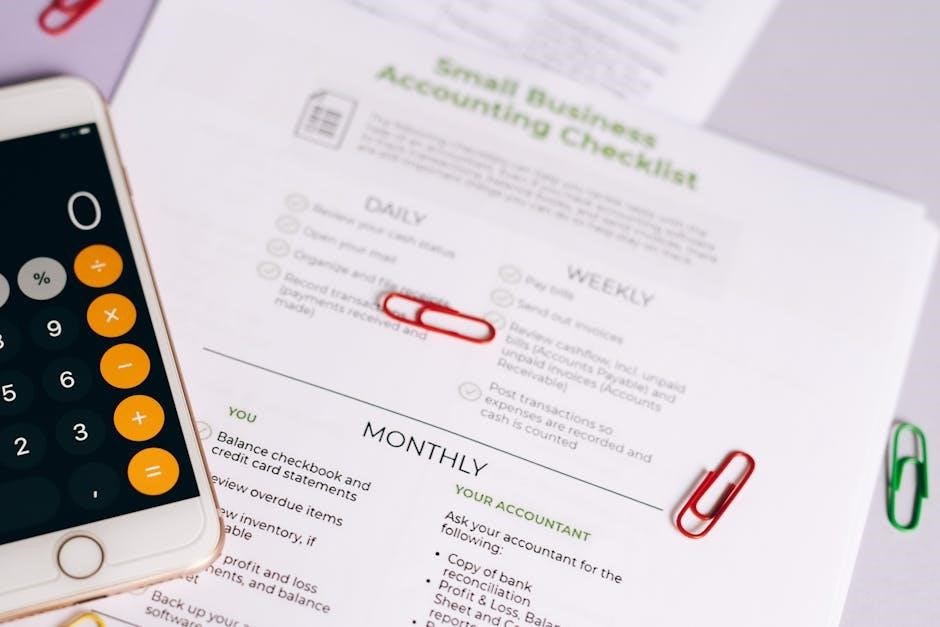A server side work checklist is a vital tool for ensuring consistency and efficiency in restaurant operations. It outlines essential tasks servers must perform daily to maintain seamless service, from preparation to closure, ensuring everything runs smoothly and efficiently;
Importance of a Server Side Work Checklist
A server side work checklist is essential for maintaining consistency, efficiency, and accountability in restaurant operations. It ensures that all tasks, from opening to closing, are completed systematically, reducing the risk of oversight. By following a structured checklist, servers can prioritize duties, manage their time effectively, and contribute to a seamless customer experience. This tool also helps in maintaining cleanliness, organization, and preparedness, which are critical for operational success. Additionally, it fosters teamwork and accountability, as each server knows their responsibilities. Implementing a checklist enhances overall service quality, ensuring that every shift starts and ends on a productive note. It is a simple yet powerful resource that streamlines workflows and supports the smooth functioning of a restaurant.
Overview of Server Side Responsibilities
Server side responsibilities encompass a wide range of tasks essential for ensuring smooth restaurant operations. These duties include preparing for service, such as turning on lights, adjusting music, and sanitizing areas. Servers must also manage their stations, restock supplies, and maintain cleanliness throughout their shift. During service, they handle customer interactions, manage orders, and ensure seamless communication with the kitchen staff. Beyond direct customer service, servers are responsible for sidework, including refilling condiments, organizing storage areas, and preparing for the next shift. These tasks, often detailed in a server side work checklist, ensure that servers contribute effectively to both front-of-house and behind-the-scenes operations, supporting the overall efficiency and success of the restaurant.

Key Components of a Server Side Work Checklist
A server side work checklist includes essential tasks such as turning on lights, sanitizing areas, restocking supplies, and organizing stations to ensure smooth operations and readiness for service.
Start of Shift Tasks
At the beginning of their shift, servers must complete a series of critical tasks to prepare for service. This includes turning on lights, adjusting window blinds, and activating background music to create a welcoming ambiance. They also need to sanitize areas such as the kitchen pass-through window and service counters to maintain hygiene standards. Additionally, servers should restock essential supplies like napkins, condiments, and POS receipt paper. Assigning server numbers on the POS system and reviewing the Manager’s Log Book are also crucial steps to ensure smooth communication and task delegation. By systematically addressing these start-of-shift tasks, servers can ensure a well-organized and efficient service environment for customers.
During Service Tasks
During service, servers must maintain a clean and efficient environment to ensure seamless operations. This includes sanitizing service areas like the kitchen pass-through window and cleaning around the POS system. Refilling supplies such as cups, lids, and condiments at the drink station is essential to prevent shortages. Additionally, servers should monitor waste areas to ensure they are clean and free of debris. They must also check and replenish POS receipt paper throughout the service to avoid interruptions. Ensuring that all service stations are well-stocked and organized helps maintain a smooth workflow. These tasks are critical for providing excellent customer service and supporting the overall efficiency of the restaurant during peak times.
Closing Shift Tasks
Closing shift tasks are essential for maintaining a clean and organized restaurant environment. Servers must sanitize surfaces, clean and restock service areas, and ensure all equipment is turned off. They should dispose of trash and recyclables, wipe down POS systems, and replenish supplies for the next shift. Additionally, servers are responsible for folding napkins, restocking condiments, and ensuring all service stations are tidy; Cleaning windows and exterior areas to maintain a welcoming appearance is also crucial. These tasks ensure the restaurant is prepared for the next day, promoting efficiency and a smooth transition between shifts. By completing these duties, servers contribute to a well-maintained workspace and a positive customer experience.

Server Sidework Responsibilities
Server sidework involves a series of essential tasks that ensure smooth restaurant operations. These responsibilities include opening, mid-shift, and closing duties, such as restocking supplies, sanitizing areas, and organizing service stations to maintain efficiency and cleanliness throughout the day.
Opening Sidework Duties
Opening sidework duties are crucial for setting up a smooth service. Servers must start by turning on lights, adjusting window blinds, and activating background music to create a welcoming atmosphere. Additionally, they should sanitize the kitchen pass-through window and clean any debris from the front of the house. Restocking essential items like napkins, utensils, and receipt paper is also vital. Assigning server numbers on the POS system ensures efficient order management. These tasks ensure the restaurant is ready for guests, promoting a clean, organized, and functional environment from the start of the shift.
Closing Sidework Duties
Closing sidework duties ensure the restaurant is prepared for the next service. Servers must clean and sanitize service areas, including the POS system and drink stations. Restocking supplies and organizing utensils and condiments are essential. Folding napkins and ensuring dispensers are filled maintains a neat appearance. Exterior duties include removing trash and cleaning windows for a clear customer view. These tasks promote a smooth transition between shifts, ensuring everything is ready for the next day. Proper completion of closing duties helps maintain efficiency, hygiene, and a professional environment, setting the stage for successful future operations.
Mid-Shift Sidework Duties
Mid-shift sidework duties ensure the restaurant remains organized and efficient during service. Servers should clean and sanitize high-touch areas, such as counters and POS systems, to maintain hygiene. Restocking supplies, like napkins, utensils, and condiments, prevents delays during busy periods. Sanitizing service areas and wiping down surfaces keeps the environment clean. Refilling drink stations with cups, lids, and ice ensures readiness for customer requests. Additionally, servers should polish utensils, restock condiments, and clean service trays to maintain a professional appearance. These tasks, often completed during slower moments, ensure smooth operations and prevent disruptions. Using a checklist, servers can track progress and ensure all mid-shift duties are completed efficiently, contributing to a seamless dining experience for customers.

Tools for Creating a Server Side Work Checklist
Digital checklist templates and PDF formats are essential tools for creating server side work checklists. They provide customizable frameworks, ensuring tasks are organized and easily trackable for efficiency.
Digital Checklist Templates
Digital checklist templates are a modern solution for streamlining server side work responsibilities. They provide a structured format that can be easily customized to meet specific restaurant needs. These templates often include predefined tasks, such as opening sidework, mid-shift duties, and closing procedures, ensuring nothing is overlooked. By leveraging digital tools, servers can access checklists via mobile devices or tablets, enhancing accessibility and efficiency. Many templates also allow for real-time tracking, enabling managers to monitor progress and ensure accountability. Additionally, digital templates can be quickly updated to reflect changes in operations or seasonal requirements. They are a valuable resource for maintaining organization and consistency in daily tasks, making them an essential tool for modern restaurant management.
PDF Format Checklist Benefits
PDF format checklists offer numerous advantages for server side work management. They are easily downloadable and printable, ensuring accessibility for all staff members. PDFs maintain consistency in formatting across different devices, providing a clear and professional appearance. Their compatibility with various platforms allows seamless sharing and accessibility. PDF checklists can be used to lead pre-shift meetings, ensuring tasks are organized and assigned effectively. They also serve as a reliable reference for training new staff, promoting uniformity in procedures. Additionally, PDFs can be archived for record-keeping, helping to track compliance and performance over time. Overall, PDF checklists are a practical and efficient tool for managing server side work responsibilities, enhancing productivity and consistency in restaurant operations.

Best Practices for Implementing a Server Side Work Checklist
Customize the checklist to fit your restaurant’s unique needs, ensuring it aligns with daily operations. Train staff thoroughly to maximize efficiency and consistency in task completion.
Customizing the Checklist
Customizing the checklist involves tailoring it to your restaurant’s specific needs and workflow. Start by identifying the unique tasks and responsibilities that are essential for your establishment. Review existing templates and adapt them to include duties such as restocking supplies, sanitizing areas, and preparing for service. Ensure the checklist covers all shifts, including opening, mid-shift, and closing tasks. Consider the size and layout of your restaurant, as well as any special equipment or procedures that require attention. By making the checklist relevant and comprehensive, you can ensure that all servers understand their roles and contribute to a smooth operation. Regularly update the checklist to reflect changes in your restaurant’s operations or priorities.
Training Staff to Use the Checklist
Training staff to use the checklist effectively is crucial for its success. Begin by explaining the importance of each task and how it contributes to overall restaurant efficiency. Demonstrate how to use the checklist, ensuring they understand the structure and sequence of tasks. Provide hands-on practice during slow periods or training sessions, allowing servers to familiarize themselves with the process. Encourage questions and feedback to address any confusion. Regularly review the checklist with the team to reinforce its use and importance. Consider using visual aids or digital tools to make training engaging and accessible. By investing time in proper training, your staff will be better equipped to follow the checklist consistently, ensuring smooth operations and a positive customer experience.
